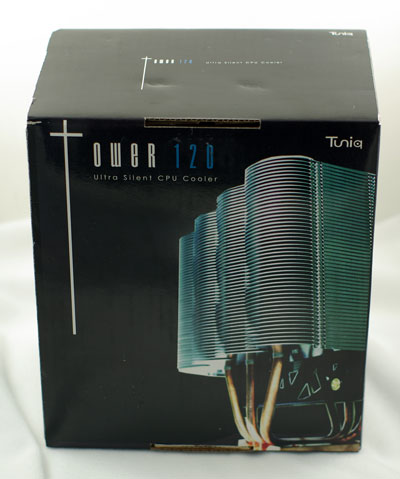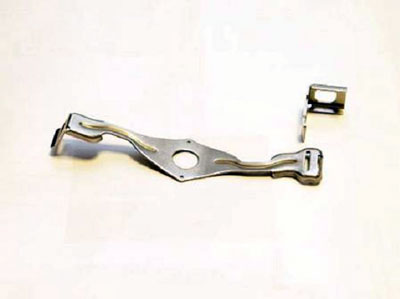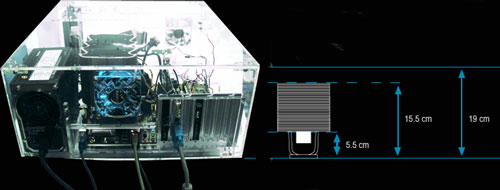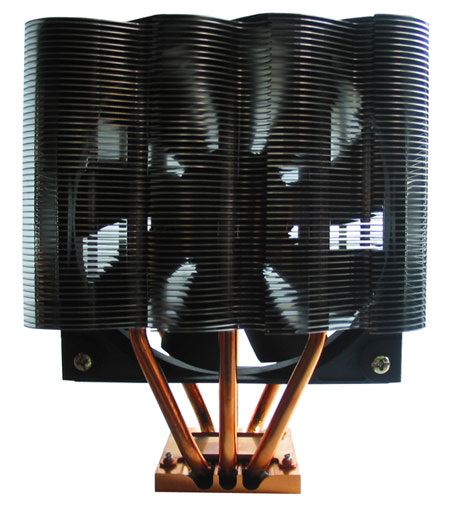Tuniq Tower 120: Air Cooling to the Max
by Wesley Fink on January 15, 2007 12:01 AM EST- Posted in
- Cases/Cooling/PSUs
Sunbeam Tuniq Tower 120

The Tuniq Tower 120 is manufactured by Sunbeam Company, a company based in Taiwan with manufacturing in mainland China. Sunbeamtech was founded in 2000, and the company specializes in PC modding, performance enhancement solutions, and PC cases. Tuniq is a subsidiary of Sunbeam, producing coolers like the Tuniq Tower 120 and specialized PC cases.

The Tower 120 consists of a massive 120mm 9-blade fan in the core of three closed heatpipe loops cooled with a huge number of thin aluminum fins for heat dissipation. The package comes with the special 9-blade fan, a small tube of high performance thermal grease, a fan controller that can mount in an empty expansion slot, and the adapter plate for Intel Socket 775 or AMD K8 (939/940/754).
The Tuniq is very heavy compared to standard heatsinks, which generally fall in the 400g to 650g weight range. At 798g without the fan you will find the final operating weight of the Tuniq 120 close to a kilogram (2.2 lbs). However, this is in line with coolers that take a similar approach to cooling like the Scythe Infinity.

The package does NOT include the adapter for the AMD AM2 processor, but Tuniq tells us the Tower 120 will work on AM2 by using the Zalman ZM-OC1 adapter, which is pictured above. This can be purchased as an accessory from Zalman retailers.

The Tuniq Tower 120 is a massive heatsink, designed to fit mid-tower and full-tower cases. At first glance you may wonder how it could possibly fit in a case, but the height is a bit less than the dimensions of a standard case and the Tuniq will definitely fit a standard case. While the cooler is very large in both width and length it is small at the base. As a result the bulk is above most onboard components around the CPU socket. The bottom line is the Tuniq will fit most motherboards with no problems.

While any 120 mm fan can be used with the Tuniq, the stock fan has 9-blades instead of the more common 7-blade design. This is said to move more air at the same RPM, which allows the fan to be effective at low speeds that are also very quiet. Tuniq strongly encourages that you use the stock fan.

The unit comes standard with a slot-mount fan controller. Specifications indicate the fan dial adjusts fan speed from 1000 to 2000 RPM. These values are very low compared to smaller fans that must run at much higher speeds to be effective. The down-side of higher speed fans is that fan noise normally increases with speed. It is clear Sunbeam chose this huge 120mm fan with 9 blades to reduce noise in this design.










50 Comments
View All Comments
imaheadcase - Monday, January 15, 2007 - link
I just put that artic cooler freezer Pro 7 (thats a mouthfull) on to replace my stock HSF, that itself made a HUGE difference. I got it for $25 at newegg.Before, I was running top speed 1.86ghz @ 2.8ghz with stock HSF. When i put on Freezer pro I hit 3.2ghz without any voltage change, but now its 48c at 3.2ghz vs 62c at 2.8ghz! Pretty impressive no matter how you dice it.
I'm guessing its just all heatpipe heatsinks that help a ton with cooling over stock HSF.
Araemo - Monday, January 15, 2007 - link
Not all 'heatpipe heatsinks', you can still design a heatsink badly with heatpipes. But most of the highest performance heatsinks use heatpipes to increase their efficiency, or to allow amazing masses of metal that would not fit around the CPU socket directly. My current heatsink looks a bit like an old style heatsink, but with 4 heatpipes coming out of the thick base and extending through the fins an inch higher and off to the sides.. it cools VERY well.I've also seen similar looking heatsinks w/ heatpipes that cool worse than stock AMD and Intel heatsinks.
slayerized - Monday, January 15, 2007 - link
It is indeed a fair way to compare this with the stock heat sink. It would be more insightful to compare the results with other available products such as Zalman. Good review anyway!Wesley Fink - Monday, January 15, 2007 - link
Other cooling reviews are in the works. Eventually we will have a cooling database that will compare all the top cooling solutions.We have found the Intel Retail HSF to be a decent cooler - particularly on a C2D. We needed to test the Retail Intel as a base line for future cooling tests.
mostlyprudent - Monday, January 15, 2007 - link
Very nice article. I would love to see a review of the Thermalright HR-01-775. I have heard reports that it is capable of passively cooling an E6400.poohbear - Monday, January 15, 2007 - link
yea i just wanna echo the above sentiment that we all know its better than stock, but how about comparing it to the top 5 coolers on the market to get an idea of how good it is? nonetheless, nice to finally see a heatsink review on anandtech.:)shank2001 - Monday, January 15, 2007 - link
Don't forget to test the Scythe Infinity when you do your comparisons. I think it may just beat the Tuniq! Amazing heatsink!xsilver - Monday, January 15, 2007 - link
I would like to request reviews of HSFs in the lower price bracket as well as this one. ($30 us approx.) eg. are you getting the extra $20 worth if you go for the tuniqalso the tuniq isnt readily available in some parts of the world :( so reviews of more easily obtained products would be good.
Wesley Fink - Monday, January 15, 2007 - link
A low cost cooler roundup is in the works. Roundups always require lots of bench time so it will be several weeks before you will see the roundup at AT.xsilver - Monday, January 15, 2007 - link
oh alsoanother good idea may be to also bench all new coolers against paradigm coolers of the past the people may be privvy to keeping/using such as the zalman 7000 / thermalright xp-90/120 and seeing how they compare to newer HSF units or even if they beat stock coolers anymore?